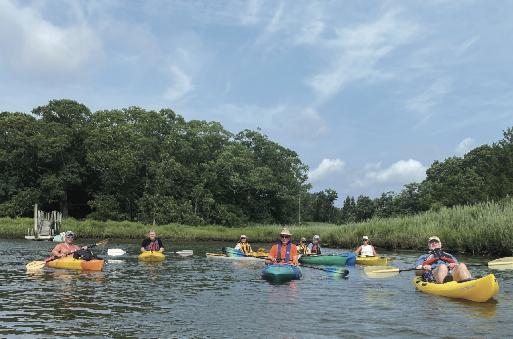News
Cutchogue Library Tour
"As part of the Association's expanded social calendar, members of the Association were given a tour of the Cutchogue Library in December. It included a visit to each of the Library's departments with a discussion of the many resources available and the activities offered by the Library. The tour concluded with a fascinating discussion with the Library's historian and refreshments in the Library's art gallery."
The Tick Situation Is Getting Worse -
The New York Times 6/17/25
The Tick Situation Is Getting Worse. Here’s How to Protect Yourself.
As temperatures rise, ticks of several kinds are flourishing in ways that threaten people’s health.
Listentothisarticle·6:50min Learnmore
By Maggie Astor
Published June 16, 2025 Updated June 17, 2025, 10:35 a.m. ET
Lately, Shannon LaDeau and her colleagues have had unwelcome visitors at their office in New York’s Hudson Valley: ticks, crawling up the building and trying to get through doors.
“Which is kind of alarming,” said Dr. LaDeau, a disease ecologist at the Cary Institute of Ecosystem Studies who studies the arachnids and the pathogens they carry.
As winters get warmer, ticks of several kinds are flourishing. Deer ticks, known for transmitting Lyme disease, are moving farther north. The longhorned tick, which came from overseas, has gained a foothold on the East Coast and begun moving west. Gulf Coast ticks have made it to states like Connecticut and Indiana. The lone star tick, which can make people allergic to red meat, is fanning out from the South and has been found as far as Canada.
And even in places long accustomed to them, ticks are becoming more numerous and active for longer stretches of each year.
Why is this happening, and how can you protect yourself? We asked the experts.
What changes are researchers seeing?
Marc Lame, an entomologist and clinical professor emeritus at Indiana University’s School of Public and Environmental Affairs, put it simply: “There are more and different types of ticks around than there used to be, and I don’t see that stopping anytime soon.”
The spread of individual species can be difficult to track. The longhorned tick, for example, was not identified in the United States until 2017, but a recent study confirmed that it was here as early as 2010.
But there is evidence they are traveling across North America quickly: On its northern front in Canada, the deer tick — also known as the blacklegged tick — is believed to be extending its range more than 20 miles per year, said Catherine Bouchard, a research scientist at the Public Health Agency of Canada.
The movement of the lone star and longhorned ticks particularly worries Laura Goodman, an assistant professor in Cornell’s Department of Public and Ecosystem Health, because it takes so few to establish themselves in a new
place. Both can breed in huge numbers — a single longhorned tick can lay 2,000 eggs. Female longhorned ticks can even reproduce alone, essentially cloning themselves through a process called parthenogenesis.
Some ticks are also behaving differently. Dr. Bouchard said that when she began studying deer ticks in southern Quebec around 2007, they stopped looking for someone to bite by October. Now, it is not unusual for her to see them in December.
Is this because of climate change?
Yes, in large part.
There are other factors at play, such as deer populations recovering along the East Coast after years of decline. But “there’s a clear scientific consensus that climate change is playing a role,” said Michael Dietze, who leads Boston University’s Ecological Forecasting Lab.
Because temperatures are rising, ticks and the animals they travel on — like deer and mice — are likelier to survive winters, and new territory is becoming hospitable.
Climate change also explains why ticks are emerging earlier in the spring and staying active later in the fall: They can be active whenever the temperature is above about 39 degrees Fahrenheit.
What are the health implications?
As deer tick populations grow, cases of Lyme disease, the most common tick- borne illness in the U.S., appear to have risen.
Data from the Environmental Protection Agency suggests Lyme cases have been increasing for 30 years. The agency warns that changes in how the disease is defined and reported make it hard to confirm that this reflects a real trend. But while scientists may not have exact numbers, Dr. Dietze said rates had “definitely increased.”
Researchers are seeing indications of increases in other tick-borne diseases, too, including anaplasmosis, babesiosis, ehrlichiosis and Rocky Mountain spotted fever. All are treatable if caught early, but they can sometimes be fatal. Also on the rise is alpha-gal syndrome, an allergy to red meat usually caused by the lone star tick.
Experts worry that, as different tick species feed on the same animals in newly overlapping habitats, they could share diseases.
A single tick may also become more likely to carry multiple pathogens — meaning someone could get Lyme disease and receive treatment without their doctor realizing they also need treatment for, say, babesiosis.
Dr. Goodman had been working with Defense Department funding to develop one test for numerous tick-borne illnesses, but the Trump administration halted her grant.
How can you protect yourself?
Unfortunately, while Lyme disease vaccines and anti-tick treatments are available for dogs, they currently aren’t for humans, so your best bet is to try to prevent bites in the first place.
Keep in mind that ticks don’t only live in the woods. While deer ticks tend to favor wooded areas, they and other species also frequent parks and lawns — and some even approach buildings.
Health authorities recommend wearing long pants and long sleeves when you might be exposed, and tucking your shirt into your pants and your pants into socks or boots. Repellents containing DEET are effective on skin, and permethrin on clothing.
Once you get indoors, check yourself carefully — and check children and pets as well, said Negar Elmieh, a scientist at Canada’s National Collaborating Center for Environmental Health. Ticks may bite anywhere, but they are often drawn to warm, damp areas such as the backs of knees and the groin, underarms, ears and scalp.
If you find a tick, remove it. Companies sell many removal devices, but tweezers work fine. Grasp the tick where it meets the skin and pull steadily, without jerking or twisting. Then disinfect the area and wash your hands.
There are a few safe ways to dispose of a tick. Centers for Disease Control and Prevention recommendations include drowning it in alcohol or wrapping it tightly in tape. Don’t crush it with your fingers, because pathogens can enter your body through tiny breaks in the skin that you might be unaware of.
Most tick-borne diseases, including Lyme, offer a grace period: You can prevent transmission if you remove the tick within a certain number of hours.
But this may not be true for all diseases. So if you develop a fever, rash, body aches, joint pain or unusual fatigue — or other symptoms that concern you — see a doctor.
Maggie Astor covers the intersection of health and politics for The Times.
Causeway Playground Reopening Celebration
Help Protect Fawns
If you Care, Leave It There!
Have you ever come upon a fawn, or pair of fawns, curled up and motionless without any sign of an adult doe around?
Before assuming fawns are orphaned, consider the following:
White-tailed deer typically give birth to fawns in mid-late May to early June. Newborn fawns will be hidden away while the doe is out feeding. Fawns will lie quietly, often not moving to avoid attracting predators. A doe will only return to feed her fawns every 4-5 hours. Sometimes, the doe will move them to a new location during the cover of twilight. After a few weeks, the fawns will be strong enough to accompany the mother, and agile enough, to outrun most predators.
If you find a fawn alone and quiet but alert, it’s likely healthy and being cared for. If you’re concerned about the fawn’s wellbeing, observe from a distance over a period of hours, keeping children and pets away. Avoid repeated visitation, adult does may not approach if people are close by. If someone has unfortunately already handled a fawn, quickly return the fawn to the exact spot where it was found and leave the area; the adult doe will return in search of her fawn once the area is safe.
If you do encounter a fawn that is obviously injured or orphaned, call a Wildlife Rehabilitator for advice and help. They are the only people legally allowed to receive and treat distressed wildlife. They have the experience, expertise, and facilities to successfully treat and release wild animals back into the wild, where they belong.
Save Our Turtles
Motorists are Encouraged to Give Turtles ‘A Brake’
The months of May and June mark the start of fair weather and with it, the emergence of New York’s turtle species! They are migrating to habitat for basking, foraging, and nesting. Female turtles are seeking nesting areas to lay their eggs and may need to risk crossing roads to get to these habitats. Unfortunately, thousands of turtles are killed each year when struck by vehicles in New York State. Please never remove a turtle from the wild to ‘rescue’ it or take it to an area with fewer roads. Turtles are familiar with the landscape and may try to return, and risk crossing more roads. Removing even one adult female turtle from the wild can hurt local populations.
Here are some tips to help turtles this nesting season:
If possible, reduce traveling speed and stay vigilant around ponds, wetlands, or other turtle crossing hot spots—where there may be turtle crossing signs.
Stop only if you can safely do so, signal properly when pulling over, and park entirely off the road.
Do not pick turtles up by their tails. Most turtles, other than snapping turtles, can be picked up safely by the sides of their shell. Use a secure grip, as turtles may kick at your hands to loosen your hold. Dropping a turtle can damage their shell and developing embryos within females. Move the turtle off the road in the direction it is facing.
What if it's a snapping turtle?
Snapping turtles have an extremely muscular jaw and long necks that can ‘snap’ or extend backwards over the shell to inflict a defensive bite. (*Safety note*: snapping turtles can spin quickly and kick vigorously when gripped and lifted – use appropriate caution.)
Using thick gloves, use both hands to grip it by the rear of the shell near the tail and drag the turtle onto a mat or blanket and then safely across the road.
A licensed wildlife rehabilitator may be able to help if an injured turtle is found.
Leaveturtlesinthewild—donottakethemhomeaspets.A llamphibiansandreptiles native to New York are protected by New York State Environmental Conservation Law.
Scam Prevention
Take a precaution to prevent scams involving your deed/title. Suffolk County provides a free tool that will alert you when a filing is recorded against your property. It is called Homeowner Watch List (HOWL) To sign up go to www.suffolkcountyny.gov/clerk and on homepage select HOWL.
Gas Leaf Blowers
MARK NEVITT Associate Professor of Law at Emory University School of Law,
FEBRUARY 7, 2023
Restricting gas-powered leaf blowers can positively affect the health of people and the planet.
This piece was first published in The Regulatory Review on February 6, 2023. It is reprinted with their permission.
As nations gathered in Sharm el-Sheikh, Egypt, last fall for the latest United Nations climate conference, the language of complex international climate negotiations—“loss and damage,” “nationally determined contributions,” “global stocktake”—can seem far removed from the realities of our day-to-day life. For the growing chorus of people concerned about climate change but unsure of the next steps to avert climate disaster, listen to the noise emanating from the yard next door. We should work collectively to regulate, and ultimately ban, gas-powered leaf blowers in our neighborhoods.
Consider what happens every fall in my new hometown of Atlanta. It is a time of crisp days, stunning foliage, and cool nights. Sadly, Atlanta’s autumn beauty is too often disrupted by the ear-splitting sound of gas-powered leaf blowers. Every morning, landscaping companies deploy these gigantic beasts across the city, strapped to workers’ backs like dystopian World War II-era flamethrowers. The enemies are Atlanta’s leaves, and the leaf-blowers are determined to disrupt office Zoom calls, infants’ naps, and the peace and tranquility of your home.
What is so wrong with these gas-powered monstrosities? Let me count the ways.
First, their environmental and climate impacts are horrific. This technology relies on a combustible mix of oil and gas. A typical leaf blower reportedly burns just 60 percent of its fuel—the rest is spewed into the atmosphere. The two-stroke gas engines that power most leaf blowers use is an antiquated technology that has been phased out in nearly all areas—except yard work. But what is off-limits for driving and boating apparently remains just fine for residential neighborhoods.
In 2011, engineers at the car company Edmunds estimated that driving a Ford F-150 Raptor truck from Texas to Alaska would emit the same amount of air pollution as a mere half-hour of yard work with a two-stroke, gas-powered leaf blower. Indeed, Edmunds estimated that some gas leaf- blowers generate 23 times the carbon dioxide of the Raptor and 300 times more non-methane hydrocarbons. Both contribute to climate change and harm public health. Worse yet, gas-powered leaf blowers also emit nitrous oxide. The EPA estimates that the impact of one pound of nitrous oxide on warming the atmosphere is almost 300 times that of an equivalent pound of carbon dioxide. Professor Karen Jubanyik at Yale School of Medicine has astutely noted that lawn equipment may become one of the country’s largest sources of pollution.
Second, gas-powered leaf blowers are loud. Really loud. Some gas-powered leaf blowers generate a roar at 100 decibels, laying waste to topsoil, insects, and the environment while blasting air at 280 miles an hour. That 100-decibel roar is the same noise level as a passenger jet taking off. And it is not just the decibel level—the kind of noise is particularly pernicious. Leaf blowers operate at a low frequency, penetrating concrete walls and the inner sanctum of homes with ease. Some gas-powered leaf blowers can be heard nearly three football fields away.
Third, gas-powered lawn care has been linked to debilitating health issues, such as cancer, asthma, heart disease, and hearing loss. Workers are exposed to the air pollution and noise from leaf blowers at close range and over sustained periods of time. The Centers for Disease Control and Prevention found that one-quarter of Americans between ages 20 to 69 already suffer from diminished hearing. This outcome is due in large part to ambient urban noise, including sirens, traffic, and leaf blowers. Permanent hearing loss can occur with just 15 minutes of exposure at the highest decibel level that gas-powered leaf blowers operate. Author James Fallows has noted that “noise is the secondhand smoke of the era.”
The health impacts of leaf blowers also pose equity issues. Low-wage workers suffer the most. Tragically, they are almost assured to develop hearing issues if they are exposed to this mechanical madness on a daily basis.
Thankfully, some jurisdictions have started to take notice. To date, over 100 cities and towns across the country have banned or restricted the use of gas-powered leaf blowers. Washington, D.C., did so earlier this year. California will be phasing out gas-powered leaf blowers after it discovered that gas leaf blowers and related lawn care equipment emit more ozone pollution than all of California’s tens of millions of cars, combined.
But gas-powered leaf blowers are still legal in many states, including my newly adopted state of Georgia. Earlier last year, the Georgia state legislature even considered prohibiting any jurisdiction from banning gas-powered leaf blowers.
Landscape companies argue that electric leaf blowers are just not powerful enough compared to gas leaf blowers, and they say that the transition to electric will impose an increased cost. These arguments are—pardon the pun—overblown.
Although there may be a modest upfront cost to make the transition to electric, companies can manage these costs if bans are phased in over a few years or adopted with tax credits to help offset the transition—a successful strategy in some jurisdictions. And any cost—real or perceived—must be balanced against the noise pollution, environmental impacts, and health costs that continue from prolonged delay. Furthermore, battery equipment technology has advanced considerably and provides a much lower cost of ownership over time.
Gas-powered leaf blowers may seem like a seasonal, minor, “first-world problem” that is far removed from the weighty negotiations that took place in Egypt last fall. They are not. They are a serious public health problem that also pose significant harm to the atmosphere and environment.
The return of tranquility as the wind wooshes through the tree canopy is a worthy goal. But so is acting locally on global climate change while reducing harmful health impacts to workers and community residents alike. Let us start regulating gas-powered leaf blowers out of our neighborhoods.
Breaking News
Click Image to Expand.
Fall 2021 – Summer Essay Contest
Fall 2021 – Summer Essay Contest
Two essays were selected as winners of the inaugural Nassau Point Essay contest. Each participant has reflected their memories of many activities, and resulting fun, from the summer of 2021. Their enthusiasm and appreciation of their experiences are self-evident. A brief introduction follows of each winner. Their essays are also linked.
Deirdre Browne – Didi is a 13-year-old, 8th grader attending South Orange Middle School. Also a resident of South Orange (New Jersey), Didi is active with Irish Dancing and plays field hockey. She has “spent every summer of my life there (on Nassau Point) with cousins” and has enthusiastically reported that last year her family purchased a home on Wunneweta Road.
Luke Newhart – Just turning 11 on November 11th, Luke is a 5th Grader at Francophone Charter School in Oakland, CA. He and his family live in Alameda, CA. Luke came to Nassau Point this summer, making that his seventh trip to visit grandparents. Luke has many hobbies and interests, including being a Webelo Scout, a guitar player, and a volunteer to take care of Guide Dog puppies.
NPPOA Members Annual Cocktail Party
NPPOA Members 100th Anniversary Cocktail Party July 22, 2023
A member’s special 100th Anniversary celebration Cocktail Party was held at the beautiful waterfront home of hosts Debra and Michael Thompson. Many thanks to them for graciously offering the use of their wonderful backyard for the event.
The setting couldn’t have been better. The expansive tent aided by a beautiful offshore breeze helped to keep everyone comfortable on the hot July evening.
A record 180 plus people attended the 100th Anniversary inspired two-hour party which served gourmet appetizers and a large assortment of wines, beers, Proseccos, LIV canned cocktails and soft drinks. An extra special thank you goes to all our members who kept our long-standing tradition alive, by bringing their favorite hors d’ oeuvre to share with all. The combination made for a delicious bountiful spread.
Elegant flowers adorned each golden linen draped tabletops, compliments of North Fork Flower Farm. While people mingled and enjoyed the lovely surroundings, the talented local musician, Chris Hurley entertained them with his vocals and guitar throughout the event.
A special thank you to the Events Committee for all their hard work: Carrie Blair, Noreen Fisher, Andi Parks and Jane Weiland as well as all who came to lend a hand. Justin Blair, Rip Fisher, Rick Mayne and Ed Weiland, without whose help all would have been drinking warm beverages.
Thank you everyone! Donna Mayne, Events Committee Chairperson
A special video and lots of pictures were taken during the party, which will be posted shortly. I hope you can spot yourself in at least one of them.
HAPPY 100 YEARS NASSAU POINT, CHEERS!!














































